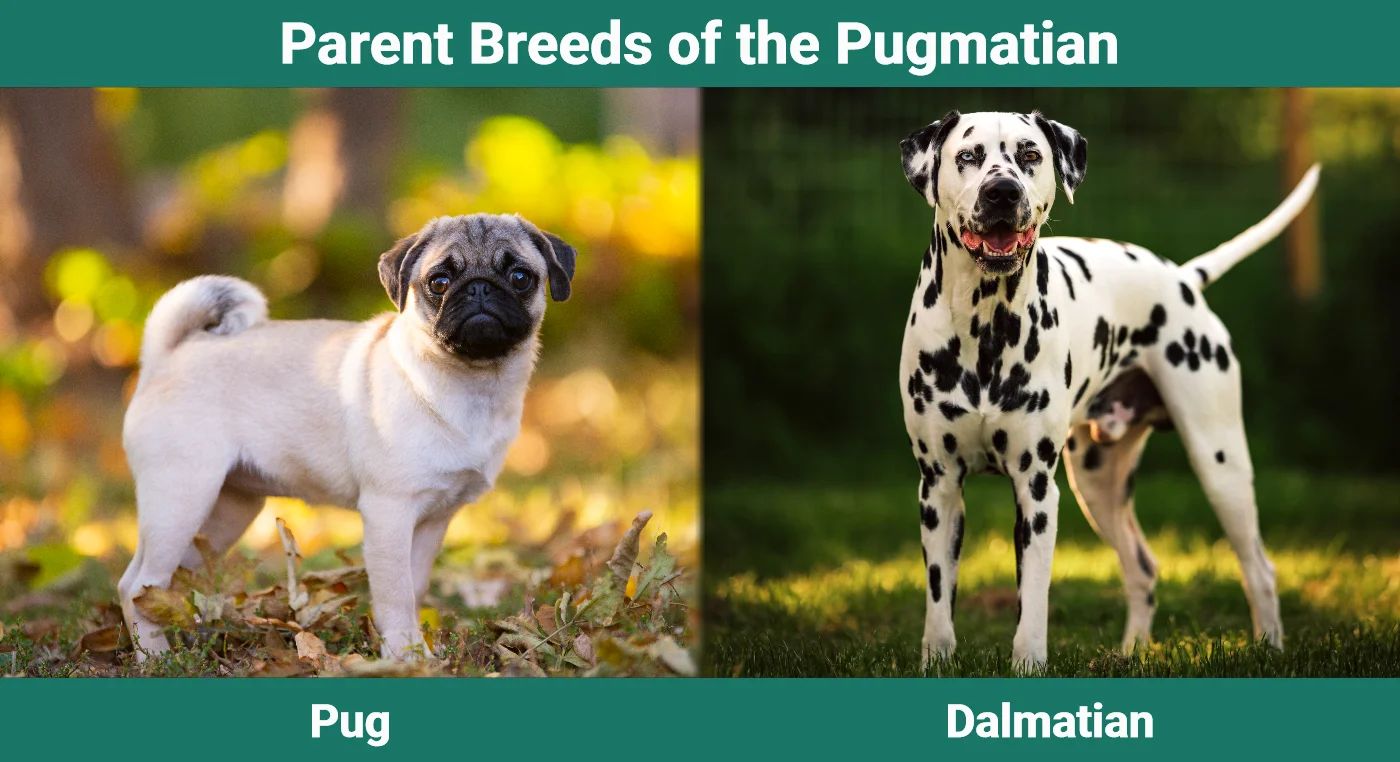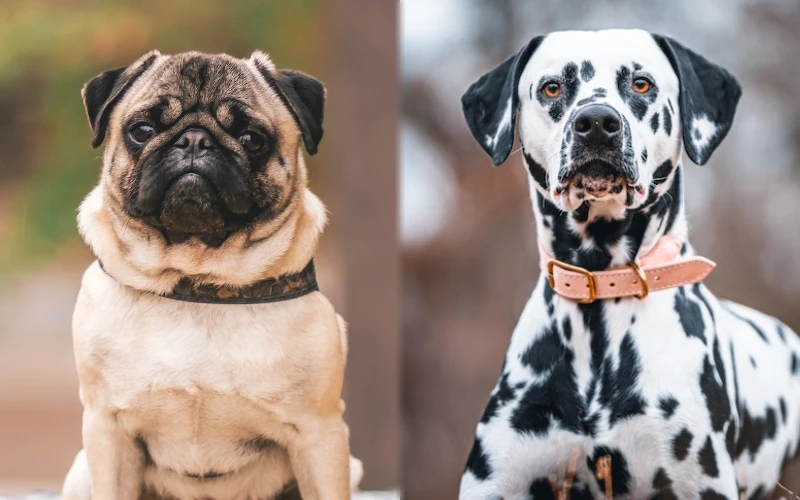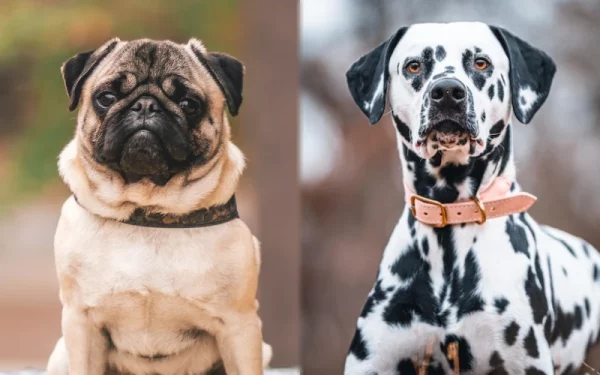Click Below to Skip Ahead
Are you looking for a dog breed that combines cuteness and elegance in one adorable package? Look no further than the Pugmatian. This unique and charming hybrid breed brings together the playful and affectionate nature of the Pug with the striking and sophisticated looks of the Dalmatian. With its distinctive coat pattern and expressive eyes, the Pugmatian is sure to turn heads wherever it goes. But it’s not just about looks – this lovable companion also has a heart of gold. Known for their friendly and sociable nature, Pugmatians are great with children and other pets, making them the perfect addition to any family.
Breed Overview
Height:
12–15 inches
Weight:
15–25 pounds
Lifespan:
10–13 years
Colors:
Black, blue, gray, tan, rust, White, bi-colored rust and white
Suitable for:
Singles for families looking for easy going dogs that are affectionate
Temperament:
Loyal & loving, intelligent, easy to train, friendly, gets along with other pets
The Pugmatian is a medium-sized dog with a friendly and playful personality. With proper training and socialization, the Pugmatian can be a well-behaved and obedient pet. People love their relaxed and affectionate nature. This hybrid dog breed requires regular exercise and mental stimulation to keep them happy and healthy.
Pugmatian Breed Puppies
Pugmatian breed puppies are generally intelligent and eager to please, which makes training relatively straightforward. They respond well to positive reinforcement techniques and enjoy learning new tricks and commands. Additionally, they have a strong sense of loyalty towards their owners, which makes them excellent watchdogs despite their small size. Overall, Pugmatian breed puppies are an excellent choice for those seeking a friendly, playful, and low-maintenance companion. With proper care, training, and socialization, these puppies can grow into loving and well-adjusted adult dogs that bring joy and happiness to their owners’ lives.

Temperament & Intelligence of the Pugmatian 🧠
Are These Dogs Good for Families? 👪
Yes. Pugmatians make great family pets due to their friendly and affectionate nature. One of the reasons why Pugmatians are good for families is their adaptability. These dogs can thrive in various living situations, whether it be in an apartment or a house with a yard. They don’t require a lot of exercise and are content with short walks or play sessions.
This makes them suitable for families who may not have the time or space for a high-energy dog. Despite their size, Pugmatians can also be very protective of their family members, making them excellent watchdogs. Also, Pugmatians have a gentle and laid-back temperament, which makes them great companions for children. They’re known to be patient and tolerant, even when kids may pull on their ears or tail.
Does This Breed Get Along With Other Pets? 🐶 😽
Pugmatians generally get along well with other pets, but it’s important to introduce them to other pets properly. Whether it be cats or other dogs that you have in your house, you must let them get used to each other slowly and not try to force anything. Over time, the Pugmatian and your other pets should at least learn to coexist peacefully.
Things to Know When Owning a Pugmatian
Food & Diet Requirements 🦴
Like all dogs, the Pugmatian needs a diet that is rich in proteins, as it’s essential for their muscle development and maintenance. Good sources of protein for this breed can include lean meats like chicken, turkey, and fish. It’s also important to include carbohydrates in their diet, which provide them with the energy they need to stay active. Whole grains like brown rice and oats are excellent sources of carbohydrates for Pugmatians.
In addition to proteins and carbohydrates, Pugmatians also require essential vitamins and minerals to support their immune system and overall health. Fruits and vegetables are great sources of these nutrients. Incorporating vegetables like carrots, peas, and sweet potatoes into their meals can provide them with important vitamins and minerals such as vitamin A, vitamin C, and potassium.
It’s crucial to maintain an appropriate portion size for your Pugmatian’s meals to prevent overeating and weight gain. These dogs are prone to obesity, so it’s essential to feed them the right amount of food based on their age, size, and overall activity level. Consulting with a vet can actually help you determine the appropriate portion sizes for your specific dog.
Exercise 🐕
The Pugmatian is a unique and mildly energetic dog breed that only requires about 30 minutes of exercise a day to stay healthy. And although their exercise requirements may vary depending on individual needs, there are some general guidelines to follow. Daily exercise is crucial to prevent them from becoming bored or overweight – and they aren’t super-active as a breed. So, a combination of mental stimulation (like games and puzzles) and physical exertion is ideal for this breed. Taking them for a brisk walk or jog in the morning and evening can help burn off excess energy and keep them mentally stimulated.
In addition to regular walks, engaging in interactive play sessions can be beneficial for the Pugmatian. They enjoy playing fetch, tug-of-war (with a rope or chew toy), and participating in agility training. These activities not only provide physical exercise but also help strengthen the bond between the dog and their owner.
But note that every dog is unique, and their exercise requirements may vary. So, factors like age, health condition, and individual personality should be considered when determining the appropriate amount and intensity of exercise for these pups.
Training 🎾
While each individual dog may have its own unique little personality and characteristics, it can generally be said that Pugmatians are relatively easy to train. Thanks to their lineage on both sides, Pugmatians actually tend to be intelligent dogs, which can make the training process smoother and more efficient. Their intelligence allows them to quickly grasp commands and understand what is expected of them.
Pugmatians are generally sociable dogs, which can make them more open to learning and interacting with their trainers. However, it’s important to note that individual Pugmatians may exhibit variations in their trainability due to their genetic makeup and individual personalities. Some may be more stubborn or independent-minded, which can make training more challenging. Here are some tips to help train them.
Keep a Routine
These dogs thrive on routine and repetition, so it’s essential to establish consistent rules and expectations. This means using the same commands and cues consistently, as well as providing consistent consequences for both good and bad behavior. For example, if you want to teach your Pugmatian to sit, always use the same command word and reward them when they successfully sit. Similarly, if your dog sits by your feet when you eat, consistently ignore or redirect their behavior to something else to discourage this.
Break Down Training Tasks
One of the best ways for training a Pugmatian is breaking down complex tasks into smaller steps. Dogs learn best when tasks are broken down into small, manageable parts. For instance, if you want to train your Pugmatian to fetch a ball, start by teaching them to pick up the ball in their mouth. Once they’ve mastered this step, move on to teaching them to bring the ball back to you. By breaking down complex tasks into smaller steps, you can help your dog understand and succeed in learning new behaviors.
Use Verbal Cues
Another effective trick for training a Pugmatian is using verbal and visual cues. These pups are highly receptive to both verbal and visual signals. So, by pairing a verbal command with a specific hand signal or gesture, you can reinforce your Pugmatian’s understanding of the command and make it easier for them to follow. For example, when teaching your dog to lie down, you can say “down” while simultaneously lowering your hand towards the ground. Over time, your dog will associate the word and hand signal with the action of lying down.
Lastly, it’s important to remember that training a dog requires time and patience. Like all dogs, Pugmatians learn at their own pace, and some may require more time and repetition than others. It’s important to remain consistent, positive, and understanding throughout the training process.
Grooming ✂️
Pugmatians have a unique coat that requires regular brushing, bathing, and maintenance to keep them clean and healthy. Here are some ways to take care of their coats and some general grooming tips.
Brush Them Regularly
Firstly, regular brushing is crucial for pugs as it helps to remove loose hair and prevent matting. Pugmatians tend to have a short, double coat that sheds moderately throughout the year, similar to that of their Pug and Dalmatian lineage. To brush your Pugmatian effectively, use a soft-bristle brush or a rubber grooming mitt. Start by brushing against the direction of hair growth to remove any loose hair, and then brush in the direction of hair growth to smooth the coat. Pay extra attention to areas such as the neck, chest, and hindquarters where matting is more likely to occur. Remember to be gentle while brushing as pugs have sensitive skin.
Bathe Them Every 2–3 Months
Regular bathing is necessary to keep your Pugmatian clean and odor-free. Pugmatians are prone to skin allergies and infections, so it’s important to use a mild, hypoallergenic shampoo specifically made for dogs. Avoid using human shampoos as they can be too harsh for a dog’s sensitive skin. Before bathing your Pugmatian, make sure to thoroughly brush their coat to remove any tangles or mats. When bathing, be careful not to get water in their eyes or ears as this can cause irritation or infection.
Pay Attention to Their Eyes
Pugmatians can inherit certain eye conditions from their parent breeds. They tend to have large, expressive eyes that are prone to eye problems like dryness or infections. Regularly cleaning and checking your Pugmatian’s eyes is essential for maintaining their overall health and well-being. By cleaning their eyes on a regular basis with a cloth (and canine eye solution), you can prevent the buildup of dirt, dust, and debris that may cause irritation or infections. Also, checking their eyes allows you to identify any signs of redness, discharge, or abnormal behavior that may indicate an underlying eye problem.
Clean & Check Their Ears
Cleaning your Pugmatian’s ears is an important part of their grooming routine. Regular cleaning helps prevent infections and keeps their ears healthy. To clean their ears, start by gathering the necessary supplies, such as an ear cleaning solution and cotton balls. Gently lift your Pugmatian’s ear flap and inspect the ear for any signs of redness, discharge, or odor. If you notice any abnormalities, it’s best to consult your vet before proceeding with the cleaning. If everything looks normal, saturate a cotton ball with the ear cleaning solution and gently wipe the inside of the ear, being careful not to insert the cotton ball too far into the ear canal. Repeat this process with a fresh cotton ball for the other ear.
Health and Conditions 🏥
- Obesity
- UTIs
- Skin allergies
- Deafness
- Respiratory problems
- Eye issues
Minor Conditions
- Obesity – Another common health issue for Pugmatians is obesity. Pugmatians have a tendency to overeat and gain weight easily, which can lead to a variety of health problems. Obesity can contribute to respiratory difficulties, joint problems, and heart disease. It’s important for owners to monitor their Pugmatians’s diet and ensure they aren’t overfeeding them. Regular exercise is also crucial for maintaining a healthy weight in pugs. Taking them for daily walks or engaging in interactive play can help prevent weight gain and keep them physically fit.
- UTIs – One of the most well-known health issues for Pugmatians is urinary tract problems. This breed has a genetic predisposition to developing urinary stones, specifically urate stones. This is due to a deficiency in their ability to metabolize purines, resulting in an excessive production of uric acid. The uric acid then crystallizes and forms stones in the urinary system. These stones can cause discomfort, pain, and even blockages if left untreated. Pugmatians may exhibit signs such as frequent urination, blood in the urine, or straining to urinate.
- Skin Allergies – Skin allergies are also a common health concern for Pugmatians. These dogs have sensitive skin that can easily become irritated or inflamed due to environmental allergens, such as pollen, dust mites, or certain foods. Allergic reactions in Dalmatians can manifest as itching, redness, rashes, or even hair loss. To prevent this, owners should identify and avoid potential triggers, such as switching to hypoallergenic dog food or using allergen-free bedding. Regular grooming and bathing can also help to alleviate symptoms and maintain the health of their skin and coat.
Serious Conditions
- Deafness – One common health issue for Pugmatians is deafness, because deafness is common in Dalmatians. It’s estimated that around 10–12% of Dalmatians are born deaf in one or both ears. This is due to a genetic mutation that affects the development of the inner ear. Deafness in Dalmatians can be detected through various hearing tests, such as the Brainstem Auditory Evoked Response (BAER) test. It’s important for owners to be aware of this potential issue and take appropriate measures to ensure the safety and well-being of their deaf Dalmatian. This may include using visual cues for training and providing a secure environment to prevent accidents or injuries.
- Respiratory Problems – One common health issue for pugs is respiratory problems. Due to their short snouts and flat faces, pugs can have difficulty breathing properly, especially in hot or humid weather. This can lead to respiratory distress, panting, and snoring. Additionally, Pugmatians are prone to developing respiratory infections and pneumonia. To minimize the risk of respiratory issues, it’s important to keep pugs in a cool and well-ventilated environment and avoid exposing them to extreme temperatures.
- Eye Issues – Pugmatians are also prone to eye problems, such as corneal ulcers and dry eye. Their bulging eyes are more exposed and susceptible to injury or irritation, which can lead to corneal ulcers. Dry eye occurs when the eyes don’t produce enough tears to keep them moist and lubricated. This can cause discomfort, redness, and potential damage to the cornea. Regular eye examinations by a vet are important for detecting and treating these issues early on.
Male vs Female
One of the main differences between male and female Pugmatians is their size. Generally, male Pugmatians tend to be slightly larger and heavier than females. This is because male dogs typically have more muscle mass and bone density. However, it’s important to note that individual dogs can vary greatly in size, so this is not always the case. If you have a preference for a smaller or larger dog, it may be worth considering the average size differences between males and females.
Another difference between male and female Pugmatians is their behavior. Again, there are no hard and fast rules, but there are some general tendencies that can be observed. Male Pugmatians tend to be more independent and assertive, while females are often more affectionate and laidback. This isn’t to say that all males or females will exhibit these traits, as individual personalities can vary greatly. However, if you have a specific temperament in mind for your dog, it may be worth considering these general tendencies.
3 Little-Known Facts About the Pugmatian
1. They’re Adaptable
The Pugmatian has a moderate energy level that makes them suitable for various living situations. While they enjoy playtime and exercise, they aren’t overly active dogs. This makes them adaptable to apartment living and suitable for families with busy schedules. They’re content with a daily walk or play session and will happily curl up on the couch with their owners.
2. They’re Usually Friendly Like Their Pug Parent
They tend to inherit the playful and friendly nature of the Pug parent. Pugs are known for their fun-loving and sociable personalities, and the Pugmatian is no exception. They love to play and interact with their owners and are great companions for families with children. Their rather cheerful disposition makes them a joy to be around and ensures they are always the center of attention.
3. They May Get Their Coat from Dalmatians
The Pugmatian can inherit the distinctive coat pattern of its Dalmatian parent. While most Dalmatians have black spots on a white coat, the Pugmatian can have a variety of colors and patterns. Some Pugmatians may have black spots on a white coat, while others may have brown or brindle spots. This makes each Pugmatian unique and adds to their charm.
Final Thoughts
When considering whether a Pugmatian dog breed is a good fit for you, there are a few factors to take into account. They’re known to be sociable and really friendly, making them great companions for families or individuals who enjoy having a constant presence around them. Also, they’re not high-energy dogs or large dogs, so if you prefer a dog that’s small to medium in size and doesn’t need an hour-long walk every day, these little happy pups may be perfect for you.
See Also:
- Dalmador (Dalmatian & Lab Mix): Pictures, Guide, Info, & Care
- Pugapoo Dog Breed Guide: Info, Pictures, Care & More
Featured Image Credit: Left – Steshka Willems, Pexels | Right – Jozef Fehér, Pexels











